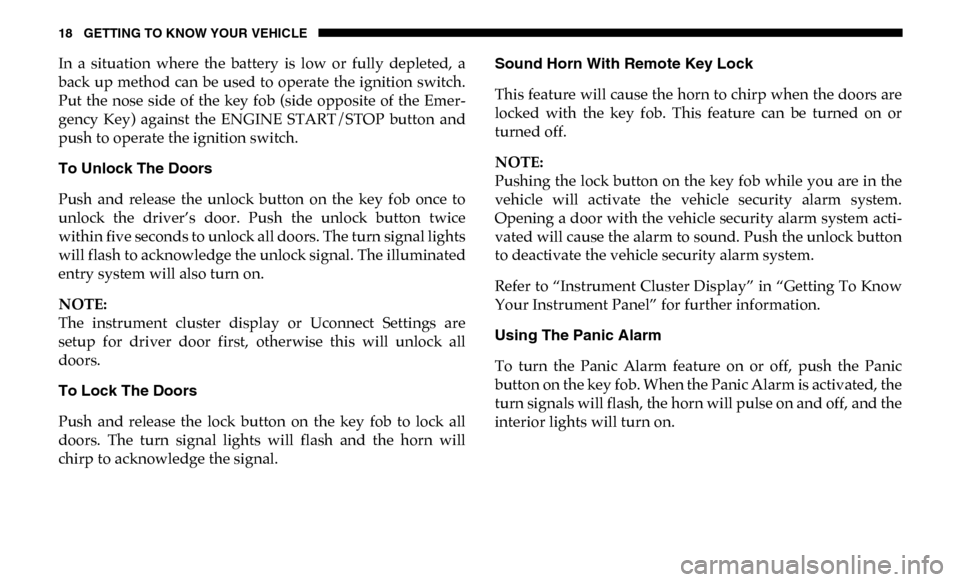engine Ram 3500 Chassis Cab 2019 Owner's Manual
[x] Cancel search | Manufacturer: RAM, Model Year: 2019, Model line: 3500 Chassis Cab, Model: Ram 3500 Chassis Cab 2019Pages: 607, PDF Size: 10.72 MB
Page 2 of 607

INSTALLATION OF RADIO TRANSMITTING
EQUIPMENT
Special design considerations are incorporated into this
vehicle’s electronic system to provide immunity to radio
frequency signals. Mobile two-way radios and telephone
equipment must be installed properly by trained person-
nel. The following must be observed during installation.
The positive power connection should be made directly
to the battery and fused as close to the battery as possible.
The negative power connection should be made to body
sheet metal adjacent to the negative battery connection.
This connection should not be fused.
Antennas for two-way radios should be mounted on the
roof or the rear area of the vehicle. Care should be used
in mounting antennas with magnet bases. Magnets may
affect the accuracy or operation of the compass on
vehicles so equipped.
The antenna cable should be as short as practical and
routed away from the vehicle wiring when possible. Use
only fully shielded coaxial cable.
Carefully match the antenna and cable to the radio to
ensure a low Standing Wave Ratio (SWR).Mobile radio equipment with output power greater than
normal may require special precautions.
All installations should be checked for possible interfer-
ence between the communications equipment and the
vehicle’s electronic systems.
WARNING:
Operating, servicing and maintaining a
passenger vehicle or off-road highway
motor vehicle can expose you to chemicals
including engine exhaust, carbon monoxide,
phthalates, and lead, which are known to
the State of California to cause cancer and
birth defects or other reproductive harm.
To minimize exposure, avoid breathing
exhaust, do not idle the engine except as
necessary, service your vehicle in a
well-ventilated area and wear gloves or
wash your hands frequently when servicing
your vehicle. For more information go to
www.P65Warnings.ca.gov/passenger-vehicle.
VEHICLES SOLD IN CANADA
With respect to any Vehicles Sold in Canada, the name
FCA US LLC shall be deemed to be deleted and the name
FCA Canada Inc. used in substitution therefore.
DRIVING AND ALCOHOL
Drunken driving is one of the most frequent causes of
accidents.
Your driving ability can be seriously impaired with blood
alcohol levels far below the legal minimum. If you are
drinking, don’t drive. Ride with a designated non-
drinking driver, call a cab, a friend, or use public trans-
portation.
WARNING!
Driving after drinking can lead to an accident.
Your perceptions are less sharp, your reflexes are
slower, and your judgment is impaired when you
have been drinking. Never drink and then drive.
This manual illustrates and describes the operation of
features and equipment that are either standard or op-
tional on this vehicle. This manual may also include a
description of features and equipment that are no longer
available or were not ordered on this vehicle. Please
disregard any features and equipment described in this
manual that are not on this vehicle.
FCA US LLC reserves the right to make changes in design
and specifications, and/or make additions to or improve-
ments to its products without imposing any obligation
upon itself to install them on products previously manu-
factured.
Copyright © 2018 FCA US LLC
Copyright © 2019 FCA US LLC
Page 7 of 607

5
WARNING LIGHTS AND MESSAGES ........................ 146
Red Warning Lights .................................................... 146
Yellow Warning Lights............................................... 150
Yellow Indicator Lights .............................................. 155
Green Indicator Lights ................................................ 156
White Indicator Lights ................................................ 157
Blue Indicator Lights ................................................... 158
ONBOARD DIAGNOSTIC SYSTEM — OBD II ........ 158
Onboard Diagnostic System (OBD II)
Cybersecurity ............................................................... 159
EMISSIONS INSPECTION AND MAINTENANCE
PROGRAMS ..................................................................... 159
SAFETY
SAFETY FEATURES ......................................................... 161
Anti-Lock Brake System (ABS) ................................. 161
Electronic Brake Control System .............................. 162
AUXILIARY DRIVING SYSTEMS .................................. 174
Forward Collision Warning (FCW) With Mitigation —
If Equipped ................................................................... 174
Tire Pressure Monitoring System (TPMS) ............ 177
OCCUPANT RESTRAINT SYSTEMS ...........................187
Occupant Restraint Systems Features ......................187
Important Safety Precautions.....................................188
Seat Belt Systems .........................................................189
Supplemental Restraint Systems (SRS).....................202
Child Restraints ..........................................................214
Transporting Pets ......................................................240
SAFETY TIPS ...................................................................240
Transporting Passengers ............................................240
Exhaust Gas ..............................................................240
Safety Checks You Should Make Inside The
Vehicle ..........................................................................241
Periodic Safety Checks You Should Make Outside The
Vehicle ...........................................................................243
STARTING AND OPERATING
STARTING THE ENGINE ..............................................244
Automatic Transmission.............................................245
Tip Start Feature ..........................................................245
Keyless Enter-N-Go — Ignition ................................. 245
Normal Starting Using ENGINE START/STOP
Button .........................................................................246
Cold Weather Operation (Below –22°F Or −30°C) ... 250
After Starting ................................................................250
ENGINE BLOCK HEATER — IF EQUIPPED............... 251
Page 8 of 607

6
ENGINE BREAK-IN RECOMMENDATIONS ............ 251
PARKING BRAKE ........................................................... 252
AUTOMATIC TRANSMISSION .................................... 254
Ignition Park Interlock ................................................ 255
Brake/Transmission Shift Interlock System ........... 256
Six–Speed Automatic Transmission —
If Equipped .................................................................. 256
Eight-Speed Automatic Transmission .................... 265
FOUR-WHEEL DRIVE OPERATION —
IF EQUIPPED .................................................................... 272
Four-Position Electronically Shifted Transfer Case —
If Equipped .................................................................. 272
Manually Shifted Transfer Case — If Equipped ..... 277
LIMITED-SLIP DIFFERENTIAL .................................... 281
POWER TAKE OFF OPERATION — IF EQUIPPED
(CHASSIS CAB ONLY) ................................................... 281
Stationary Mode .......................................................... 282
Mobile Mode ................................................................ 283
POWER STEERING .......................................................... 283
Hydraulic Power Steering .......................................... 283
SPEED CONTROL ........................................................... 285
To Activate.................................................................... 285
To Set A Desired Speed...............................................286
To Vary The Speed Setting .........................................286
To Accelerate For Passing .......................................... 287
To Resume Speed.........................................................288
To Deactivate ................................................................288
ADAPTIVE CRUISE CONTROL (ACC) —
IF EQUIPPED ..................................................................288
Adaptive Cruise Control (ACC) Operation .............290
Activating Adaptive Cruise Control (ACC) ............290
To Activate/Deactivate...............................................291
To Set A Desired ACC Speed.....................................292
To Cancel.......................................................................292
To Turn Off ...................................................................293
To Resume .................................................................... 293
To Vary The Speed Setting .........................................293
Setting The Following Distance In ACC ..................295
Overtake Aid ................................................................298
ACC Operation At Stop ..............................................298
Adaptive Cruise Control (ACC) Menu.....................299
Display Warnings And Maintenance .......................300
Precautions While Driving With ACC .....................302
General Information ....................................................306
Normal (Fixed Speed) Cruise Control Mode...........307
Page 10 of 607

8
DRIVING TIPS................................................................... 363
Driving On Slippery Surfaces ................................... 363
Driving Through Water ............................................. 364
IN CASE OF EMERGENCY
HAZARD WARNING FLASHERS ............................. 366
ASSIST AND SOS SYSTEM — IF EQUIPPED .............. 366
BULB REPLACEMENT .................................................. 371
Replacement Bulbs ..................................................... 371
Replacing Exterior Bulbs ............................................ 373
FUSES.................................................................................. 380
Power Distribution Center ......................................... 381
JACKING AND TIRE CHANGING .......................... 390
4500/5500 Models ....................................................... 391
Preparations For Jacking ............................................ 391
Jacking Instructions 4500 And 5500 Series............... 392
To Stow The Flat Or Spare — If Equipped .......... 396
Hub Caps/Wheel Covers — If Equipped .............. 397
JUMP STARTING ............................................................ 398
Preparations For Jump Start ...................................... 399
Jump Starting Procedure ............................................ 400
IF YOUR ENGINE OVERHEATS .................................. 401
GEAR SELECTOR OVERRIDE — 6–SPEED
TRANSMISSION .............................................................. 402
MANUAL PARK RELEASE — 8–SPEED
TRANSMISSION ...............................................................403
FREEING A STUCK VEHICLE ......................................405
TOWING A DISABLED VEHICLE ...............................406
Two-Wheel Drive Models .......................................... 407
Four-Wheel Drive Models .......................................... 408
Emergency Tow Hooks — If Equipped....................408
ENHANCED ACCIDENT RESPONSE
SYSTEM (EARS) ...............................................................409
EVENT DATA RECORDER (EDR)................................. 409
SERVICING AND MAINTENANCE
SCHEDULED SERVICING ............................................410
Maintenance Plan ........................................................411
Heavy Duty Use Of The Vehicle ...............................414
ENGINE COMPARTMENT .......................................... 415
6.4L Engine ..................................................................415
Checking Oil Level — Gas Engine ...........................416
Adding Washer Fluid ................................................416
Maintenance-Free Battery .......................................... 417
Page 11 of 607

9
DEALER SERVICE ........................................................... 417
Engine Oil — Gas Engine .......................................... 418
Engine Oil Filter ......................................................... 419
Engine Air Cleaner Filter ......................................... 420
Air Conditioner Maintenance ................................. 421
Accessory Drive Belt Inspection ................................ 426
Body Lubrication ....................................................... 428
Windshield Wiper Blades ......................................... 428
Exhaust System ........................................................... 431
Cooling System ........................................................... 433
Brake System ............................................................... 438
Automatic Transmission ............................................ 439
Rear Axle And 4x4 Front Driving Axle Fluid
Level .......................................................................... 442
Transfer Case ............................................................... 444
HOISTING ......................................................................... 444
TIRES .................................................................................. 444
Tire Safety Information ............................................ 444
Tires — General Information ................................... 454
Tire Types ..................................................................... 460
Spare Tires — If Equipped ..................................... 461
Wheel And Wheel Trim Care ................................. 464
Tire Chains (Traction Devices) ................................. 465
Tire Rotation Recommendations ............................... 466
DEPARTMENT OF TRANSPORTATION UNIFORM
TIRE QUALITY GRADES ...............................................468
Treadwear .....................................................................469
Traction Grades............................................................ 469
Temperature Grades ................................................... 469
STORING THE VEHICLE .............................................470
BODYWORK ......................................................................470
Protection From Atmospheric Agents ....................470
Body And Underbody Maintenance .........................471
Preserving The Bodywork .......................................... 471
INTERIORS .......................................................................472
Seats And Fabric Parts ................................................472
Plastic And Coated Parts ............................................473
Leather Parts.................................................................474
Glass Surfaces ..............................................................474
TECHNICAL SPECIFICATIONS
IDENTIFICATION DATA ...............................................475
Vehicle Identification Number ................................. 475
BRAKE SYSTEM ...............................................................476
Hydraulic Brake Assist ...............................................476
WHEEL AND TIRE TORQUE SPECIFICATIONS .....476
Torque Specifications ................................................477
Page 12 of 607

10
FUEL REQUIREMENTS .............................................. 479
6.4L Engine ................................................................... 479
Reformulated Gasoline .......................................... 479
Materials Added To Fuel .......................................... 480
Gasoline/Oxygenate Blends .................................... 480
Do Not Use E-85 In Non-Flex Fuel Vehicles............ 481
CNG And LP Fuel System Modifications ................ 481
MMT In Gasoline......................................................... 481
Fuel System Cautions.................................................. 481
Carbon Monoxide Warnings ................................... 482
FLUID CAPACITIES ..................................................... 483
FLUIDS AND LUBRICANTS ......................................... 484
Engine ........................................................................... 484
Chassis ......................................................................... 486
MULTIMEDIA
UCONNECT SYSTEMS ................................................... 487
DRAG & DROP MENU BAR ........................................ 487
CYBERSECURITY ............................................................ 488
UCONNECT SETTINGS ................................................. 490
Uconnect 3 Settings ..................................................... 490
Uconnect 4/4C/4C NAV Settings ............................ 509
Uconnect 4C NAV With 12–inch Display Settings ..... 529
STEERING WHEEL AUDIO CONTROLS — IF
EQUIPPED .......................................................................550
Radio Operation........................................................... 550
Media Mode..................................................................551
IPOD/USB/MP3 CONTROL — IF EQUIPPED ........551
RADIO OPERATION AND MOBILE PHONES .........555
Regulatory And Safety Information .........................556
VOICE COMMANDS .....................................................557
Introducing Uconnect .................................................557
Get Started .................................................................... 557
Basic Voice Commands...............................................559
Radio..............................................................................561
Media ............................................................................. 564
Phone ............................................................................. 566
Voice Text Reply — If Equipped ...............................569
Climate (4C/4C NAV) ................................................570
Navigation (4C NAV) .................................................572
SiriusXM Guardian (4C/4C NAV) —
If Equipped ...................................................................573
Register (4C/4C NAV)................................................574
Page 14 of 607

12
INTRODUCTION
INTRODUCTION
Dear Customer, congratulations on selecting your new
vehicle. Be assured that it represents precision workman-
ship, distinctive styling, and high quality.
This is a specialized utility vehicle. It can go places and
perform tasks that are not intended for conventional
passenger vehicles. It handles and maneuvers differently
from many passenger vehicles both on-road and off-road, so
take time to become familiar with your vehicle. If equipped,
the two-wheel drive version of this vehicle was designed for
on-road use only. It is not intended for off-road driving or
use in other severe conditions suited for a four-wheel drive
vehicle. Before you start to drive this vehicle, read the
Owner’s Manual. Be sure you are familiar with all vehicle
controls, particularly those used for braking, steering, trans -
mission, and transfer case shifting. Learn how your vehicle
handles on different road surfaces. Your driving skills will
improve with experience. When driving off-road, or
working the vehicle, don’t overload the vehicle or expect the
vehicle to overcome the natural laws of physics. Always
observe federal, state, provincial and local laws wherever
you drive. As with other vehicles of this type, failure to operate this vehicle correctly may result in loss of control or
a collision. Refer to the “Driving Tips” in “Starting and Oper
-
ating” for further information.
This Owner’s Manual has been prepared with the assistance
of service and engineering specialists to acquaint you with
the operation and maintenance of your vehicle. It is supple -
mented by Warranty Information, and customer oriented
documents. In the attached Warranty Booklet you will find a
description of the services that FCA offers to its customers,
the Warranty Certificate and the details of the terms and
conditions for maintaining its validity. Please take the time
to read all of these publications carefully before driving your
vehicle for the first time. Following the instructions, recom -
mendations, tips, and important warnings in this manual
will help assure safe and enjoyable operation of your vehicle.
This Owner’s Manual describes all versions of this vehicle.
Options and equipment dedicated to specific markets or
versions are not expressly indicated in the text. Therefore,
you should only consider the information which is related to
the trim level, engine, and version that you have purchased.
Any content introduced throughout the Owner’s Informa -
tion, that may or may not be applicable to your vehicle, will
Page 20 of 607

18 GETTING TO KNOW YOUR VEHICLE
In a situation where the battery is low or fully depleted, a
back up method can be used to operate the ignition switch.
Put the nose side of the key fob (side opposite of the Emer-
gency Key) against the ENGINE START/STOP button and
push to operate the ignition switch.
To Unlock The Doors
Push and release the unlock button on the key fob once to
unlock the driver’s door. Push the unlock button twice
within five seconds to unlock all doors. The turn signal lights
will flash to acknowledge the unlock signal. The illuminated
entry system will also turn on.
NOTE:
The instrument cluster display or Uconnect Settings are
setup for driver door first, otherwise this will unlock all
doors.
To Lock The Doors
Push and release the lock button on the key fob to lock all
doors. The turn signal lights will flash and the horn will
chirp to acknowledge the signal. Sound Horn With Remote Key Lock
This feature will cause the horn to chirp when the doors are
locked with the key fob. This feature can be turned on or
turned off.
NOTE:
Pushing the lock button on the key fob while you are in the
vehicle will activate the vehicle security alarm system.
Opening a door with the vehicle security alarm system acti
-
vated will cause the alarm to sound. Push the unlock button
to deactivate the vehicle security alarm system.
Refer to “Instrument Cluster Display” in “Getting To Know
Your Instrument Panel” for further information.
Using The Panic Alarm
To turn the Panic Alarm feature on or off, push the Panic
button on the key fob. When the Panic Alarm is activated, the
turn signals will flash, the horn will pulse on and off, and the
interior lights will turn on.
Page 25 of 607

GETTING TO KNOW YOUR VEHICLE 23
Programming Additional Key Fobs
Programming the key fob may be performed by an autho-
rized dealer.
NOTE:
Once a key fob is programmed to a vehicle, it cannot be
repurposed and reprogrammed to another vehicle.
General Information
The following regulatory statement applies to all radio
frequency (RF) devices equipped in this vehicle:
This device complies with Part 15 of the FCC Rules and with
Industry Canada license-exempt RSS standard(s). Operation
is subject to the following two conditions:
1. This device may not cause harmful interference, and
2. This device must accept any interference received, including interference that may cause undesired opera -
tion.
NOTE:
Changes or modifications not expressly approved by the
party responsible for compliance could void the user’s
authority to operate the equipment.IGNITION SWITCH
Keyless Push Button Ignition
This feature allows the driver to operate the ignition switch
with the push of a button as long as the Remote Keyless
Entry key fob is in the passenger compartment.
The Keyless Push Button Ignition has four operating posi -
tions; three of which are labeled and will illuminate when in
position. The three positions are OFF, ACC, and ON/RUN.
The fourth position is START, during start RUN will illumi -
nate.
NOTE:
In case the ignition switch does not change with the push of
a button, the key fob may have a low or dead battery. In this
situation, a back up method can be used to operate the igni -
tion switch. Put the nose side (side opposite of the emer -
gency key) of the key fob against the ENGINE START/STOP
button, with your foot applied on the brake pedal, and push
to operate the ignition switch.
2
Page 26 of 607

24 GETTING TO KNOW YOUR VEHICLE
(Continued)
Keyless Push Button Ignition
The push button ignition can be placed in the following
modes:
OFF
• The engine is stopped.
• Some electrical devices (e.g. Central locking, alarm, etc.) are still available. ACC
• Engine is not started.
• Some electrical devices are available.
RUN
• Driving position.
• All the electrical devices are available.
START
• The engine will start.
1 — OFF
2 — ACC (Accessory)
3 — ON/RUN
WARNING!
• When exiting the vehicle, always remove the key fob from the vehicle and lock your vehicle.
• Never leave children alone in a vehicle, or with access to an unlocked vehicle.
• Allowing children to be in a vehicle unattended is dangerous for a number of reasons. A child or others
could be seriously or fatally injured. Children should
be warned not to touch the parking brake, brake pedal
or the gear selector.